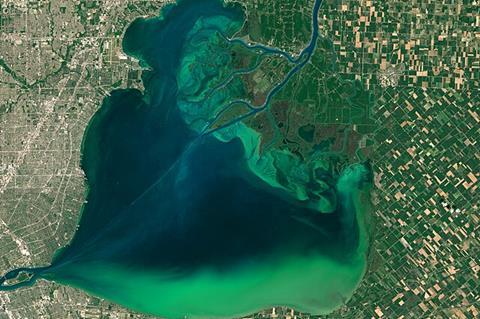To try to understand how harmful algal blooms might evolve in Lake Erie in a warming climate, University of Michigan scientists helped conduct a survey of cyanobacteria in a gulf of Kenya’s Lake Victoria.

When cyanobacteria proliferate out of control, they can form clouds of green algae called cyanobacterial harmful algal blooms, or cyanoHABs. Some types of cyanobacteria produce toxins, and so these algal blooms can not only be harmful to wildlife and livestock, but to people using the water as well.
The Winam Gulf of Kenya’s Lake Victoria, a gulf with similar limnological properties and therefore could potentially be a model for Lake Erie in a warming climate, experiences harmful algal blooms year-round.
“Our collaboration wanted to study not only harmful algal blooms, but also the social consequences of HABs in the context of the Winam Gulf being a model for a warming Lake Erie,” said Lauren Hart, lead author of the study, who completed the work as a U-M doctoral student. “Winam Gulf is one of the most productive basins in Lake Victoria for fishing, and it’s depended upon by Kenya’s third largest city, Kisumu.”
Reasons of the study
Although these algal blooms do take place year-round, previously researchers had not completed a genetic catalogue of the cyanobacteria that live in the gulf. Now, a group of researchers from North America and Kenya have completed genetic sequencing of cyanobacteria across the Winam Gulf. Their results, which will also help local officials track harmful algal blooms, are published in the journal Applied and Environmental Microbiology.
“The paper that Lauren led unmasks the synthetic capability of cyanobacterial blooms in an area plagued by year-round bloom events. Unlike in the U.S., where water treatment plants effectively remove cyanobacterial toxins, there are no such resources available in Kenya.
READ MORE: Newly discovered cyanobacteria could help sequester carbon from oceans and factories
Rural populations drink water directly from the lake, yielding exposure risks that Westerners never face,” said senior author George Bullerjahn, professor of biological sciences at Bowling Green State University. “Understanding the toxigenic capability of the Lake Victoria blooms is a first step in developing protocols to inform residents about such risks so that they may change their water use during intense bloom periods.”
Water contaminated with toxic cyanobacteria can’t be made safe by boiling. Boiling can actually make the water even less safe because boiling the toxin-producing bacteria can split bacteria open, unleashing more toxins.
Cataloguing cyanobacteria
To do a complete genetic survey of cyanobacteria in Winam Gulf, researchers took samples from the lake in 2022 and 2023. They identified a kind of cyanobacteria called Dolichospermum as the most dominant bloom-forming cyanobacteria. At most sites where the researchers found Dolichospermum, they also found another cyanobacteria called Microcystis. Microcystis and a cyanobacteria called Planktothrix were more abundant in shallow and turbid sites. All three of these cyanobacteria are also found in cyanoHABs in Lake Erie.
This was an interesting finding, Hart said, because areas of turbidity—water in which there’s a lot of suspended material, such as where rivers flow into lakes—can mask the visibility of harmful algal blooms. Harmful algal blooms can often show up as clouds of green material, but in turbid areas, water can simply appear murky.
“This was really concerning in areas where people are using the raw water because you can’t see the bloom, so you’re not practicing these habits you may practice when there is a scum,” Hart said.
Hart herself identified that the organism Microcystis produces microcystin, a toxin that can damage the liver, as well as 300 other clusters of genes responsible for producing molecules, both toxic and otherwise, according to study co-author Gregory Dick, U-M professor of earth and environmental science and director of the Great Lakes Center for Freshwaters and Human Health.
“Lauren’s work is a great example of how environmental genomics can address longstanding questions, such as which organism is producing known toxins, as well as uncover genetic potential for production of a vast diversity of other molecules of interest, some of which we didn’t even know to look for,” Dick said.
Harm to human health
Toxins can enter the human body through several pathways, including ingesting the toxins, breathing them when they become airborne, or absorbing them through the skin while bathing or laundering clothes. People who are immunocompromised are most at risk for harm from these toxins, according to Hart, who also focuses on how different toxins interact together once inside the human body.
“My work is interested in this synergy question: If microcystin and another toxin that Microcystis makes gets into our bodies at the same time, does one plus one equal four rather than two? Can one amplify the other’s effect?” Hart said. “There is a small line of research beginning to come out that finds harmful synergies between these molecules, especially when it comes to fatty liver disease and harming your gut microbiome.
“Bringing it back to the Winam Gulf, this is important because Kisumu, Kenya’s third largest city, has one of the highest prevalence of malaria and high amounts of HIV, leading to many immunocompromised people. This is going to heighten the kind of effect these cyanotoxins and exposure to HABs have on people in this region.”
Topics
- Aquatic Microbiology
- Bacteria
- Bowling Green State University
- Clean Water
- Climate Action
- cyanobacteria
- Disease in marine aquaculture
- Dolichospermum
- Environmental Microbiology
- George Bullerjahn
- Great Lakes Center for Freshwaters and Human Health
- Gregory Dick
- Healthy Land
- Kenya’s Lake Victoria
- Lake Erie
- Lauren Hart
- Marine Science
- Metagenomic
- Microbial Genetics
- microcystin
- Microcystis
- Ocean Sustainability
- Planktothrix
- Research News
- University of Michigan
- USA & Canada







No comments yet